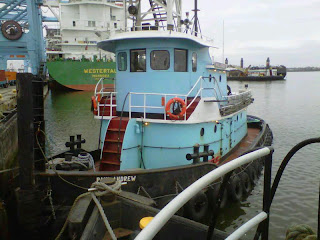
This is a light scrap scow on Gate Lines as we're heading into the Hutchinson River. This configuration of tow involves using two lines from the main bitt on the aft deck up to the scow and keeping the scow right up close behind the tug. We do this when the scow is too high to see over or around, and when we have to bring it through narrow passes where there is no room for the boat to be alongside the tow. In this case, we had to maneuver through two bridges which only afforded about 6 0r 8 feet on either side of the scow. Being up close and using two lines from our pivot point to the corners of the barge ensures that the barge stays right behind the boat as we go through these narrow passages.

Geese are a common sight around the docks, they get used to a free meal now and then from the boats.
Finally, back to some real tug boating! I guess it's all real tug boating, but since before Christmas we had been dredge tending in Newark Bay, never getting more than about 2 miles from our home dock.
When we showed up for our hitch last Thursday, we were sent over to Claremont to do shifting work among the scrap scows there. this was because the tug that usually does it was in drydock.
As with many things, I really started to enjoy it once we got into the thick of it. It is a bit more intense than some of the other work I've done around here, in that a typical day will consist of a dozen or more more moves within the yard. It's close quarters, one part of the yard has a narrow, shallow canal - and other parts involve sliding the scows in between other pieces of equipment and this requires both deckhands to be up on the scow to handle lines and give steering directions. Because of this, we were "off watches" - working a regular 10 hour day and getting our rest at night like normal workaday folks. I am not really too fond of that arrangement, as I've grown accustomed to watching the world go by 6 hrs. at a time while at work.
So we did that until Tuesday, then we got back on the scrap runs. This is great because it gets us out and about in the harbor. the first run was from Claremont up to the the Bronx river, where we exchanged a light (empty) scow for a loaded one. Boy was it great to be out in the bay again, up through the East River and Hell Gate to Hunts Point and then back down to Claremont. The running joke for the past few months was whether or not we could find these places, or know what to do once we got there.
Things are humming along here on the Brian, we've been suffering some crew problems, which isn't all that uncommon in the business, but we're soldiering on.



















